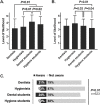Oral health care professionals recommending and administering the HPV vaccine: Understanding the strengths and assessing the barriers
- PMID: 33662007
- PMCID: PMC7932114
- DOI: 10.1371/journal.pone.0248047
Oral health care professionals recommending and administering the HPV vaccine: Understanding the strengths and assessing the barriers
Abstract
Introduction: Head and neck cancer is a deadly cancer that ranks among the six most common cancers worldwide. The HPV vaccine has been used to prevent head and neck cancer of the oropharynx, and changes in health policies and state law are impacting the role of dental professionals in HPV vaccination. However, relatively little is known about dental professionals' attitudes regarding the vaccine.
Objectives: Our study assesses dental professionals' willingness to administer the HPV vaccine, their confidence discussing HPV with patients, beliefs about the vaccine's efficacy, perceived barriers to administering it, and sites of referral.
Methods: We surveyed 623 dental professionals, including dentists, hygienists, dental students, and hygiene students across Michigan. Attitudes toward the vaccine and predictive characteristics were evaluated by logistic regression, ANOVAs, and t-tests.
Results: The majority of the respondents (51% of dentists, 63% of hygienists, 82% of dental students, and 71% of hygiene students) were willing to administer the HPV vaccine if allowed by law. The role of dental and dental hygiene students would be one of advocacy, educating and recommending the vaccine, and the dental students administering it once licensed. Dental professionals were variably confident discussing HPV with patients and generally believed it enhanced patients' health. Stronger confidence and beliefs were associated with greater willingness to administer the vaccine. Barriers among professionals opposing the HPV vaccine included lack of knowledge on the subject, liability concerns, and personal beliefs.
Conclusion: Dental professionals can become leaders in preventing HPV-related cancers. Training and continuing education courses could enhance their confidence and willingness to recommend and administer the HPV vaccine.
Policy implications: Legislation that permits dental professionals to administer the vaccine could increase the vaccine's accessibility to patients, improve vaccination rates, and population health.
Conflict of interest statement
The authors have declared that no competing interests exist.
Figures





Similar articles
-
Dental professionals' knowledge, attitudes, and practice behaviors related to human papillomavirus vaccination.J Public Health Dent. 2020 Jan;80(1):61-69. doi: 10.1111/jphd.12350. Epub 2019 Dec 1. J Public Health Dent. 2020. PMID: 31788802
-
Understanding dental hygienists' knowledge, attitudes, and practices regarding HPV vaccination.Hum Vaccin Immunother. 2025 Dec;21(1):2511484. doi: 10.1080/21645515.2025.2511484. Epub 2025 May 30. Hum Vaccin Immunother. 2025. PMID: 40444900 Free PMC article.
-
The Role of the Dental Community in Oropharyngeal Cancer Prevention Through HPV Vaccine Advocacy.J Cancer Educ. 2021 Apr;36(2):299-304. doi: 10.1007/s13187-019-01628-w. J Cancer Educ. 2021. PMID: 31728921
-
USA dental health providers' role in HPV vaccine communication and HPV-OPC protection: a systematic review.Hum Vaccin Immunother. 2019;15(7-8):1863-1869. doi: 10.1080/21645515.2018.1558690. Epub 2019 Jan 30. Hum Vaccin Immunother. 2019. PMID: 30620632 Free PMC article.
-
Human Papillomavirus: A Narrative Review for Dental Providers in Prevention and Care.Int J Environ Res Public Health. 2025 Mar 17;22(3):439. doi: 10.3390/ijerph22030439. Int J Environ Res Public Health. 2025. PMID: 40238579 Free PMC article. Review.
Cited by
-
An Analysis of Dental Hygienists' Practices and Perceptions Toward HPV Vaccination.J Cancer Educ. 2025 Aug 14. doi: 10.1007/s13187-025-02702-2. Online ahead of print. J Cancer Educ. 2025. PMID: 40813745
-
Case-finding for HPV vaccination eligibility within a dental office with concurrent development of a dialogue tool.Vaccine X. 2024 Apr 23;18:100492. doi: 10.1016/j.jvacx.2024.100492. eCollection 2024 Jun. Vaccine X. 2024. PMID: 38737622 Free PMC article.
-
Perceived barriers and facilitators to HPV vaccination: Insights from focus groups with unvaccinated mid-adults in a U.S. medically underserved area.Hum Vaccin Immunother. 2024 Dec 31;20(1):2422681. doi: 10.1080/21645515.2024.2422681. Epub 2024 Nov 13. Hum Vaccin Immunother. 2024. PMID: 39539025 Free PMC article.
-
A scoping review of evidence on routine cervical cancer screening in South Asia: investigating factors affecting adoption and implementation.Cancer Causes Control. 2025 Jan;36(1):67-79. doi: 10.1007/s10552-024-01923-y. Epub 2024 Oct 7. Cancer Causes Control. 2025. PMID: 39375278 Free PMC article.
-
HPV vaccine knowledge, attitudes, and practices among New York State medical providers, dentists, and pharmacists.Hum Vaccin Immunother. 2023 Aug 1;19(2):2219185. doi: 10.1080/21645515.2023.2219185. Hum Vaccin Immunother. 2023. PMID: 37340826 Free PMC article.
References
Publication types
MeSH terms
Substances
LinkOut - more resources
Full Text Sources
Other Literature Sources
Medical

